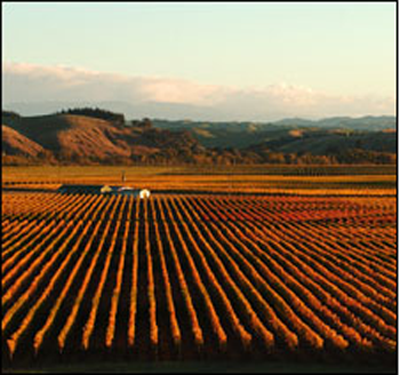Americans Are Thirsty for the New Zealand Wine Business
Date£º
2014-04-18 10:23 Source£º
winespectator Author:
MaryAnn Worobiec Translator:
As sales grow, investors are seeing potential and buying into Kiwi wineries.

Wine lovers in the United States are drinking more New Zealand wines than ever, with double-digit annual percentage increases in the value of imports for the past five straight years. As demand increases, investors are also developing a taste for Kiwi wine. Recent acquisitions in the New Zealand wine market by two U.S.-based major players¡ªFoley Family Wines and Terroir Selections¡ªsignal an increasing confidence in the wines' future.
New Zealand is one of the fastest-growing categories of wine sold in the U.S.¡ªimports grew 13 percent last year, to nearly $300 million worth of wine, according to the nation's wine trade board. America has jumped to become New Zealand¡¯s second-largest market, just behind Australia, and some industry analysts suggest the U.S. might become the largest market within a couple of years.
Foley¡¯s wine collection includes well-known California brands such as Lincourt, Kuleto, Chalk Hill, Sebastiani, Merus and Firestone. There is also Three Rivers Winery in Washington. Earlier this year the firm picked up Martinborough Vineyard Estates, adding to their New Zealand brands Te Karinga, Grove Mill and Vavasour. Foley now manages more than 1,100 acres of vines and 550,000 cases of wine production in New Zealand.
¡°We¡¯re seeing a good reception for the brands we¡¯re bringing in,¡± said owner Bill Foley. ¡°Growth [in the United States] has been about 15 percent a year.¡± He says part of the appeal of investing in New Zealand is a chance to vertically integrate within that country. In addition to vineyards and production facilities, he also owns a wine distributor, a high-end lodge and a stake in the restaurant chain Nourish. He can distribute his own wines, and sell them in his own restaurants. Multiple brands gives him an opportunity to shift grapes as needed.
Charles Banks and his winery investment group Terroir Selections acquired a controlling share of New Zealand brand Trinity Hills in February. This is Terroir Selections' first foray into New Zealand, adding to a portfolio of high-end producers in California, South Africa and Burgundy. ¡°It¡¯s an amazing place with amazing people,¡± said Banks. ¡°Why wouldn¡¯t you want to do business [in New Zealand]?"
There are many reasons to do business in New Zealand, starting with the increasing base of wine drinkers. There¡¯s also affordable land and plenty of sunshine, making it easy to ripen grapes, even in cooler climates. New Zealand wineries don¡¯t face the same water concerns that California vintners are struggling with after years of drought. The government is stable and the small population is open to investors. ¡°You don¡¯t have too much tradition to fight, and that¡¯s very appealing,¡± said Banks. ¡°You can make a very high-quality product and costs are less.¡±
It¡¯s not only large portfolios that are investing in New Zealand. Winemaker Ted Lemon is known as a Sonoma-based Pinot Noir specialist for his brand Littorai, but he¡¯s also the winemaker at Burn Cottage, in New Zealand¡¯s Central Otago region. The brand is owned by American Marquis Sauvage. Vela is a new brand founded by Ari¨¦ Dahan, Beth Ann Dahan and Max Risman, who are based in Boston. They own 60 acres of Pinot Noir, and introduced their wines to the U.S. market beginning with the 2012 vintage.
Even though Sauvignon Blanc dominates in New Zealand with nearly 70 percent of production and 85 percent of exports, Pinot Noir is drawing interest from winemakers like Etude¡¯s Jon Priest. Soon his Treasury-owned brand will introduce a New Zealand bottling to an appellation series of Pinot Noirs. ¡°I¡¯ve been excited about New Zealand Pinot Noir, and have followed the wines from Central Otago for some time,¡± said Priest.
For New Zealand, U.S.-based owners provide an inside track for distribution back in the States. The American market is tricky, with different laws for selling wine in each state. Banks said Trinity Hill had trouble getting traction before the acquisition. ¡°It¡¯s very convoluted,¡± Banks said, ¡°Adding an importer to the mix makes it very difficult.¡±
It wasn¡¯t that long ago that the New Zealand wine industry was struggling with its international presence. In 2008, a bumper crop and a bevy of new vineyard plantings coming into production suddenly flooded the global market with Kiwi wines. The industry reacted quickly, devising strategies to control yields. Now, harvesting is in line with sales projections. Since then, the country¡¯s wine exports have increased by 22 percent globally.
As American wine lovers continue to raise glasses of New Zealand wine, it¡¯s likely that more of these wines will be made by or owned by Americans. Asked if he had his eye on any other New Zealand investments, Banks replied cryptically, ¡°No doubt more to do on the horizon. Some sooner than others.¡±